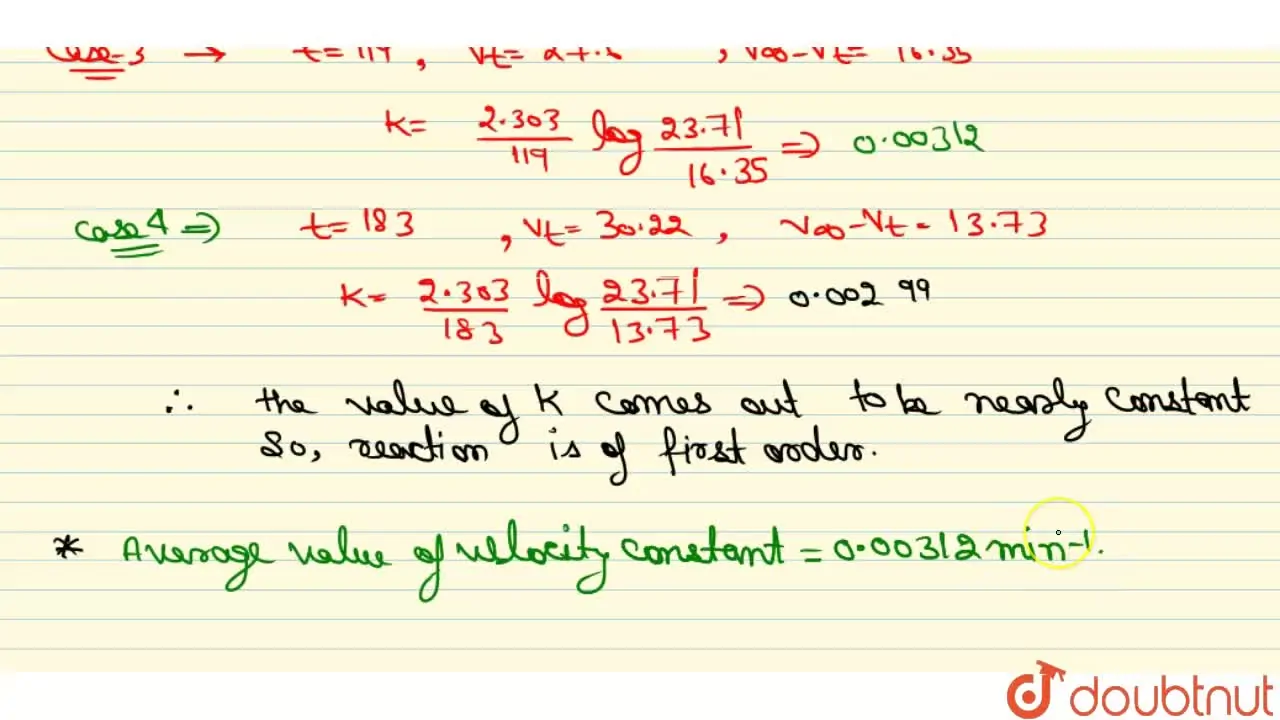1.0mL of ethyl acetate was added to 25mL of N/2HCl,2mL of the mixture were withdraw form time to time during the progress of the hydrolyiss of the ester and titrated against standard NaOH solution. The amount of NaOH required for titration at various intervals is given below:

The value at ∞ time was obtained by completing the hydrolyiss on boiling. Show that it is a reaction of the first order and find the average value of the velocity constant.
Amount of NaOH used at t=0
(V0)∝HCl present
Amount of NaOH used at any time t=t,
(Vt)∝HClpresent+CH3COOH formed.
CH3COOH formed at any time, t=∝
Ethyl acetate reacted =(Vt−V0)∝x.
Amount of NaOH used at time t=∞
(V∞)∝HClpresent + MaximumCH3COOH formed
maximum CH3COOH formed ∝ Initial concentration of ethyl acetate (V∞−V0)∝a
Hence, if the given reaction is of the first order, it must obey the equation
k=2.303tlog.aa−x=2.303tlog.V∞−V0V∞−Vt
In the present case, V0=20.24mL,V∞=43.95mL
∴V∞−V0=43.95−20.24=23.71mL
The value of k at difference instant can be calculated as follows:

Since the value of k comes out to be nearly constant, it is a reaction of first order. The value of k=0.00312−1min.
Related Playlists
- BOOK - CENGAGE CHEMISTRY ENGLISHCHAPTER - CHEMICAL KINETICSEXERCISE - Ex 4.1 (Objective)9videos
CHEMICAL KINETICS
- BOOK - CENGAGE CHEMISTRY ENGLISHCHAPTER - CHEMICAL KINETICSEXERCISE - Ex 4.2 (Objective)10videos
CHEMICAL KINETICS
- BOOK - CENGAGE CHEMISTRY ENGLISHCHAPTER - CHEMICAL KINETICSEXERCISE - Archives Subjective23videos
CHEMICAL KINETICS
- BOOK - CENGAGE CHEMISTRY ENGLISHCHAPTER - CARBOXYLIC ACIDS AND THEIR DERIVATIVESEXERCISE - Exercises Archives (Analytical And Descriptive)34videos
CARBOXYLIC ACIDS AND THEIR DERIVATIVES
- BOOK - CENGAGE CHEMISTRY ENGLISHCHAPTER - COORDINATION COMPOUNDSEXERCISE - Archives Subjective18videos
COORDINATION COMPOUNDS
Similar Questions
Acetic acid is titrated with NaOH solution. Which of the following statement is correct for this titration?
View SolutionWhen 100 ml of N/10 NaOH are added to 50 ml of N/5 HCI, the PH of the resulting solution is
View Solution2.5 g of the carbonate of a metal was treated with 100 ml of 1 NH2SO4. After the completion of the reaction, the solution was boiled off to expel CO2 and was then titrated against 1 N NaOH solution. The volume of alkali that would be consumed, if the equivalent weight of the metal is 20.
View Solution100 ml of 1M NaOH is mixed with 50ml of 1N KOH solution. Normality of mixture is
View SolutionA 100ml solution of 0.1NHCl was titrated with 0.2NNaOH solution. The titration was discontinued after adding 30mlNaOH solution. The remaining titration was completed by adding 0.25NKOH solution. The volume of KOH required for completing the titration is
View SolutionHow much water should be added to 500 mL of N2 NaOH solution to obtain a decinormal solution?
View Solution1 mL of 0.1 N HCl is added to 999 mL solution of NaCl. The pH of the resulting solution will be :
View Solution500 " mL of " 1.0 M H2C2O4, 100 " mL of " 2.0 M H2SO4, and 40g of NaOH are mixed together, 30 " mL of " the above mixture is titrated against a standard solution of sodium carbonate containing 14.3 g of Na2CO3.10H2O per 100 " mL of " solution. Find the volume of carbonate solution used for complete neutralisation.
View Solution3 gram of acetic acid is mixed in 250 mL of 0.1 M HCl. This mixture is now diluted to 500 mL. 20 mL of this solution is now taken is another container 12 mL of 5M NaOH is added to this. Find the pH of this solution. (pKa=4.74)
View Solution1g of the carbonate of a metal was dissolved in 25mL of N−HCl. Te resulting liquid 5mL of N−NaOH for neutralisation. The Ew of the metal Carbonate is
View Solution


